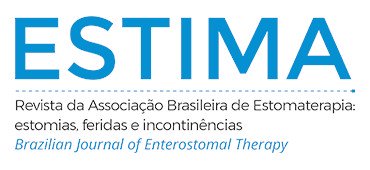INCONTINENCE-ASSOCIATED DERMATITIS: PREVALENCE AND ASSOCIATED FACTORS IN INTENSIVE CARE UNIT
Abstract
Objective: To analyze the point prevalence of incontinence-associated dermatitis (IAD) and associated factors in adult patients admitted to Intensive Care Units (ICUs). Method: A cross-sectional, observational, retrospective study carried out with 105 patients in the ICU of three university hospitals located in the state of São Paulo. The demographic and clinical variables and IAD come from the database of the research project “Prevalence of pressure injuries in the Intensive Care Unit,” composed of information from medical records and physical examination. Data were analyzed using descriptive and inferential statistics. The study was approved by the Research Ethics Committee of the proposing institution. Results: Of the 105 patients, 58 (55.24%) were male, with a mean age of 55.76 years (SD = 16.39), 105 (91.3%) had a urinary catheter and 89.4% wore diapers. Ten patients had IAD, with a point prevalence of 9.52%. The factor associated with IAD was admission due to trauma (p = 0.02). Conclusion: Studies on IAD are essential for quality, well-structured and grounded nursing care, especially in the care of critically ill patients.
Downloads
Metrics
References
Fletcher J, Beeckman D, Fumarola S, Boyles A, Kottner J, McNichol J et al. International best practice recommendations: Prevention and management of moisture-associated skin damage (MASD). London: Wounds International; 2020. [cited 2022 12 jun]. Available at: https://www.woundsinternational.com/resources/details/best-practice-recommendations-preventionand-management-moisture-associated-skin-damage-masd
Riechel SB, Fortes LFV, Amarante MV. Incontinence-associated dermatitis in hospitalized elderly patients: Nurses’ self-reported knowledge. R Pesq Cuid Fundam 2018;10(3):801-9. https://doi.org/10.9789/2175-5361.2018.v10i3.801-809
Alcoforado CLGC, Machado BO, Campos CC, Gonçales PC, Ercole FF, Chianca TCM. Fatores de risco para dermatite associada à incontinência: Uma revisão integrativa de literatura. Rev Enferm Cent-Oeste Min 2018;8:e2512. https://doi.org/10.19175/recom.v8i0.2512
Chianca TCM, Gonçales PC, Salgado PO, Machado B de O, Amorim GL, Alcoforado CLGC. Dermatite associada à incontinência: estudo de coorte em pacientes críticos. Rev Gauch Enferm 2016;37(spe):e68075. https://doi.org/10.1590/1983-1447.2016.esp.68075
Gray M, Bliss DZ, Doughty DB, Ermer-Seltun JA, Kennedy-Evans KL, Palmer MH. Incontinence-associated dermatitis: A consensus. J Wound Ostomy Continence Nurs 2007;14(1):45-56. https://doi.org/10.1097/00152192-200701000-00008
Brandão ACMAG. Dermatite associada à incontinência e os fatores associados: Estudo de prevalência em um Centro de Terapia Intensiva [dissertação]. Ribeirão Preto: Escola de Enfermagem, Universidade de São Paulo; 2017. 119p.
Belini RC, Sokem ASJ, Lima FGF, Bergamaschi FPB, Watanabe EAMT, Fietz VR. Prevalência de dermatite associada à incontinência em pacientes adultos de um hospital universitário. Cienc Cuid Saúde 2020;19:e501541. https://doi.org/10.4025/ciencuidsaude. v19i0.50154
Gray M, Giuliano KK. Incontinence-associated dermatitis, characteristics and relationship to pressure injury: A multisite epidemiologic analysis. J Wound Ostomy Continence Nurs. 2018;45(1):63-7. https://doi.org/10.1097/WON.0000000000000390
Johansen E, Bakken LN, Duvaland E, Faulstich J, Hoelstad HL, Moore Z et al. Incontinence-associated dermatitis (IAD): Prevalence and associated factors in 4 hospitals in southeast Norway. J Wound Ostomy Continence Nurs 2018;45(6):527-31. https://doi.org/10.1097/WON.0000000000000480
Cotillo-Fuente M, Valls-Matarín J, Sandalinas-Mulero I. Efficacy of a comprehensive strategy to reduce moisture-associated skin damage in an intensive care unit: A quasi-experimental study. Intensive Critic Care Nurs 2020;63(102964). https://doi.org/10.1016/j.iccn.2020.102964
Alcoforado CLGC, Lopes FO, Fernandes RA, Carvalho RLR, Guillen MRS, Ercole FF et al. Knowledge of nursing professionals about dermatitis associated with incontinence and pressure injury. Reme Rev Min Enferm 2019;23:e-1166. https://doi.org/10.5935/1415-2762.20190014
National Pressure Ulcer Advisory Panel (NPUAP); European Pressure Ulcer Advisory Panel (EPUAP); Pan Pacific Pressure Injury Alliance (PPPIA). Prevention and treatment of pressure ulcers: Clinical practice guideline. Perth, Australia: Cambridge Media; 2014. [cited 2022 12 jun] Available at: https://www.npuap.org/wpcontent/uploads/2014/08/Updated-10-16-14-QuickReference-Guide-DIGITALNPUAP-EPUAP-PPPIA-16Oct2014.pdf
Malta M, Cardoso LO, Bastos FI, Magnanini MMF, Silva CMFP. Iniciativa STROBE: Subsídios para a comunicação de estudos observacionais. Rev Saúde Pública 2010;44(3):559-65. https://doi.org/10.1590/S0034-89102010000300021
Ferreira M, Abbade L, Bocchi SCM, Miot HA, Villas Boas P, Guimaraes HQCP. Incontinence-associated dermatitis in elderly patients: prevalence and risk factors. Rev Bras Enferm 2020;73(Suppl 3):e20180475. https://doi.org/10.1590/0034-7167-2018-0475
Arnold-Long M, Johnson E. Epidemiology of incontinence-associated dermatitis and intertriginous dermatitis (intertrigo) in an acute care facility. J Wound Ostomy Cont Nurs 2019;46(3):201-6. https://doi.org/10.1097/WON.0000000000000519
Kayser SA, Phipps L, VanGilder CA, Lachenbruch C. Examining prevalence and risk factors of incontinence associated dermatitis using the international pressure ulcer prevalence survey. J Wound Ostomy Continence Nurs 2019;46(4):285-90. https://doi.org/https://doi.org/10.1097/won.0000000000000548
Wei L, Bao Y, Chai Q, Zheng J, Xu W. Determining risk factors to develop a predictive model of incontinence-associated dermatitis among critically Ill patients with fecal incontinence: A prospective, quantitative study. Wound Manag Prev 2019;65(4):24-33. https://doi.org/10.25270/wmp.2019.4.2433
Wei M, Yang D, Wu L, Chen W, Chen Y, Fu Q. The prevalence of incontinence-associated dermatitis in hospitalized patients in China: A systematic review and meta-analysis. Adv Skin Wound Care 2020;33:1-7. https://doi.org/10.1097/01.ASW.0000695764.47424.aa
Campbell JL, Coyer FM, Osborne SR. Incontinence-associated dermatitis: A cross-sectional prevalence study in the Australian acute care hospital setting. Int Wound J 2016;13(3):403-11. https://doi.org/10.1111/iwj.12322
Coyer F, Campbell J. Incontinence-associated dermatitis in the critically ill patient: An intensive care perspective. Nurs Crit Care 2018;23(4):198-206. https://doi.org/10.1111/nicc.12331
Banharak S, Panpanit L, Subindee S, Narongsanoi P, Sanun-aur P, Kulwong W et al. Prevention and care for incontinenceassociated dermatitis among older adults: A systematic review. J Multidiscip Healthc 2021;14:2983-3004. https://doi. org/10.2147/JMDH.S329672
Bliss DZ, Mathiason MA, Gurvich O, Savik K, Eberly LE, Fisher J. Incidence and predictors of incontinence associated skin damage in nursing home residents with new onset incontinence. J Wound Ostomy Continence Nurs 2017;44(2):165-71. https://doi.org/10.1097/WON.0000000000000313
Dissemond J, Assenheimer B, Gerber V, Hintner M, Puntigam MJ, Kolbig N. Moisture-associated skin damage (MASD): A best practice recommendation from Wund-D.A.CH. J German Soc Dermatol 2021;19(6):815-25. https://doi.org/10.1111/ddg.14388
Beeckman D, Van den Bussche K, Alves P, Beele H, Ciprandi G, Coyer F et al. The Ghent Global IAD Categorisation Tool (GLOBIAD). Skin Integrity Research Group - Ghent University 2017.
Chen Y, Gao Y, Zhang J, Niu M, Liu X, Zhang Y et al. Quality and clinical applicability of recommendations for incontinence associated dermatitis: A systematic review of guidelines and consensus statements. J Clin Nurs 2022; Advance online publication. https://doi.org/10.1111/jocn.16306
Downloads
Published
How to Cite
Issue
Section
License
Copyright (c) 2022 Beatriz Wiltenburg Domingues, Taís Milena Pantaleão de Souza , Laís Del Moro Cespedes Wojastyk, Vera Lucia Conceição de Gouveia Santos, Paula Cristina Nogueira

This work is licensed under a Creative Commons Attribution 4.0 International License.

























